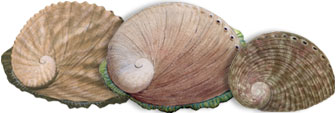
Abalone are a family of reef-dwelling marine snails. In Western Australia they are the target of a lucrative export commercial fishery and one of the world’s shortest recreational fishing seasons. Despite this fishing pressure and examples of stock collapses worldwide, WA has one of the few remaining sustainable wild-stock abalone fisheries.
The scientific family name for Abalone is Haliotidae. In Western Australia there are 11 species of abalone, but only three are large enough in size to be fished:
Brownlip abalone (Haliotis conicopora); Greenlip abalone (Haliotis laevigata); and Roe’s abalone (Haliotis roei) (above, from left to right).
Biology
Abalone are a type of single-shelled (gastropod) herbivorous marine mollusc. Their body is large and fleshy, with a broad, muscular foot the abalone uses to attach itself to reefs or rocks using suction.
The shells of abalone species are rough, flat and ear shaped, which protects them from wave action. On the inside their shells are smooth and shiny to protect the abalone’s soft flesh from damage.
Rows of small holes or ‘pores’ along the edge of their shells distinguish abalone species from other marine snails. Abalone expel water that has passed through their gills through these holes. As abalone grow, these holes progressively close-up, with usually only the last four to six holes remaining open when they reach full-size.
Distribution and habitat
Abalone are widely distributed across tropical and temperate coastal areas. Roe’s abalone can be found as far north as Shark Bay in Western Australia and south around to Victoria. They mostly inhabit shallow limestone reefs along the west coast, especially around Perth and near Geraldton.
The two larger, more valuable species – greenlip and brownlip, are found on rocks and reefs in deeper water along Western Australia’s south coast, ranging from Cape Naturaliste for greenlip and across to Rottnest Island for brownlip.
Lifecycle
Female abalone can produce millions of eggs each year. Females release their eggs into the water, where they are fertilised by sperm released by male abalone. The fertilised eggs hatch into organisms called larvae. After about a week (depending on water temperature) the tiny larvae develop into small juveniles (often called ‘spat’) and settle onto rocks.
(Abalone take about four years to reach legal size to collect, which gives females at least two spawning seasons before they can be taken by fishers.)
Diet
Juveniles feed on microscopic algae. When juveniles reach about 5 mm in length they start feeding on larger species of algae. They prefer drifting red algae.
Illustrations © R. Swainston/www.anima.net.au